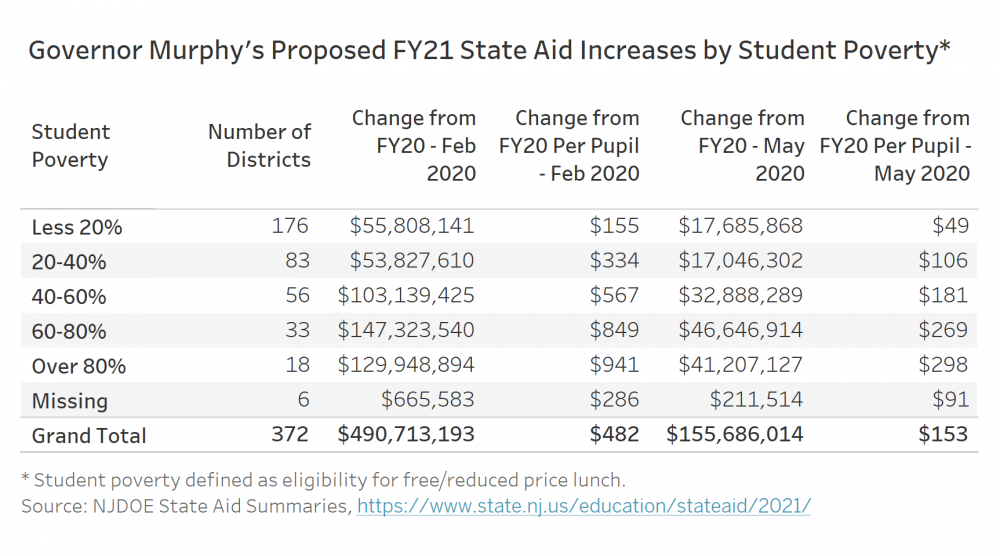GOVERNOR MURPHY TAKES $330 MILLION IN SCHOOL FUNDING OFF THE TABLE
Flat Funding and Aid Cuts Will Have Greatest Impact on New Jersey’s Poorest Districts
In late May, Governor Phil Murphy released new K-12 aid numbers for fiscal year 2021, eliminating a planned $330 million increase in state formula aid for 372 New Jersey districts. The proposed increase was the next installment of a multi-year commitment by the State to fully fund the School Funding Reform Act (SFRA), New Jersey’s weighted student funding formula.
At the same time, Governor Murphy wants to follow through on a $156 million state aid cut to 194 districts that will be redistributed to other districts under Senate Bill 2 (S2), a 2018 amendment to the SFRA championed by Senate President Stephen Sweeney.
The impact of the Governor’s proposal will fall most heavily on New Jersey’s low wealth districts segregated by poverty and race. These districts rely more on state aid, so flat funding or aid cuts have a greater impact on their budgets. The impact is much less on higher wealth districts that rely more on local property taxes.
Education Law Center calculates that, in the aggregate, high poverty districts expecting an average increase of over $900 per pupil will now only receive an additional $300 per pupil under the Governor’s proposed FY21 budget. The more affluent, low poverty districts, which expected $150 per pupil more, will now receive an extra $50 per pupil.
The Governor’s proposal would cut $156 million in state aid below current levels from 200 districts and redistribute that cut to increase aid in 372 districts. Under S2, cutting and redistributing aid was conditioned on the State fulfilling its commitment to phase in aid increases to achieve full formula funding in seven years. The Governor’s elimination of the $330 million increase has taken that commitment off the table.

“Governor Murphy is using a time-worn playbook: disproportionate state aid reductions to the poorest districts that can’t be offset by raising property taxes,” said David Sciarra, ELC Executive Director. “The proposed combination of flat funding, aid cuts and redistribution will set the State back in efforts to dismantle structural disparities in school funding resulting from our intensely segregated school districts.”
The Governor’s proposal to eliminate the $330 million increase occurs against the backdrop of 187 districts with funding levels below the constitutional level of “adequacy,” or the funding amount required to give all students the opportunity to achieve the State’s academic standards. Many of the districts with funding shortfalls under the SFRA formula serve high concentrations of students in poverty and students of color.
“Earlier this year, we recommended to the State three measures that now offer a path forward for maintaining fair and adequate school funding as the pandemic unfolds,” said Danielle Farrie, ELC Research Director.
Those measures are:
- Target any aid increases only to districts with budgets below adequacy. The Governor’s S2 proposal would redistribute $50 million to increase funding in districts already above adequacy.
- Halt aid cuts to below adequacy districts. The Governor would leave intact $89 million in aid cuts to below adequacy districts. No district currently spending below the constitutional level of adequacy should experience an aid cut, especially given the demand for increased resources as a result of COVID-19.
- Mandate a 2% property tax increase in all below adequacy districts with local revenue shortfalls in their budgets and allow these districts to exceed the 2% property tax cap to reach adequacy funding levels more quickly.
These recommendations will address the urgent need for additional resources for districts to respond to the impact of COVID-19 on their students, especially in districts already spending below constitutional funding levels. To reopen schools safely, districts will require, at a minimum, personal protective equipment, reduced class sizes, intense cleaning measures, as well as additional teachers and support staff to compensate for student learning loss and the social and emotional impact of the pandemic on students.
ELC, with its advocacy and stakeholder partners, is committed to continuing efforts to ensure the constitutional rights of public school children to an adequately funded, well-resourced education, as the New Jersey Supreme Court declared in 1998, “prominent, paramount and fully protected.”
View the Governor’s state aid proposals for FY21 at the district level here.
Related Story:
NEW JERSEY OWES $1.6 BILLION TO 187 CONSTITUTIONALLY UNDERFUNDED SCHOOL DISTRICTS
Press Contact:
Sharon Krengel
Policy and Outreach Director
skrengel@edlawcenter.org
973-624-1815, x 24
Press Contact:
Sharon Krengel
Director of Policy, Strategic Partnerships and Communications
skrengel@edlawcenter.org
973-624-1815, x240